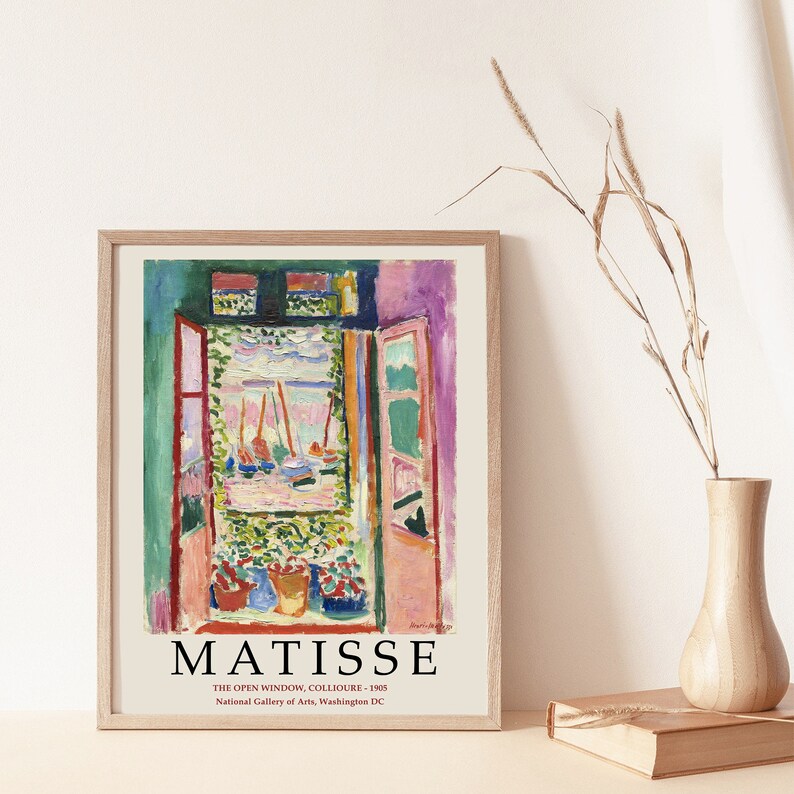

He painted the window of his room if it were a picture within a picture the grille, window jambs, and shutter frames provided an internal grid which he employed to recreate on the canvas the relationships he observed in real space.
La fenetre ouverte matisse windows#
2), but by way of compensation the windows had low-set decorative grilles which would well serve as horizontal pictorial elements to anchor and stabilize the vertical aspect of his interior compositions. There was, unfortunately, no adjoining balcony outside his new room such as that which he had put to good use the previous season (fig. In February 1920 he arrived in Nice a third time, for a stay which lasted through May, taking rooms-as he had done the previous year-in the Hôtel de la Méditerranée et de la Côte d'Azur at 25, promenade des Anglais, overlooking the beach and bay beyond. In addition to appreciating the far more amenable winter climate there than in Paris, he liked the Mediterranean light during that time of year, for although it was less dazzling than in the summer, it revealed a more subtle array of colors. Since 1917 it had become Matisse's custom to spend time in Nice for the purpose of painting during the winter months he extended his stays there with each successive visit. He created endless variations on the window's assorted movable elements-shutters, curtains and windowpanes" ( Henri Matisse: Rooms with a View, New York, 2010, p. Discarding its religious and literary associations he drew attention to the richness of this deceptively simple subject. For him, the window linked the exterior to the interior. Nor did he view it as barrier between the domestic and outside world. "Although fully aware of its long and rich history in art, to Matisse it represented neither a gateway to the spectral or of the spiritual. "A window appears in nearly one hundred of Henri Matisse's paintings," Shirley Neilsen Blum has observed. The window in this iconic painting represents the passage to a new way of painting, in which color became form. With shutters opened and thrown back, the dazzling light of a new day streams in and sets the room ablaze with color, as fresh sea breezes aerate damp and musty interior spaces. The view through a window is a perfect analogy for the art of painting, particularly as Matisse painted the window of his room in Collioure during the Fauve summer of 1905 (fig. Wanda de Guébriant has confirmed the authenticity of this work.Ī simple, everyday household feature that might best serve as a metaphor for the advent of modernism-the momentous transformation that took place in the visual arts during the first decade of the 20th century-is probably the window. "The Joseph Winterbotham Collection at the Art Institute of Chicago" in The Art Institute of Chicago Museum Studies, vol. Flam, ed., Matisse: A Retrospective, New York, 1988, p.

The Art Institute of Chicago, The Joseph Winterbotham Collection: A Living Tradition, Chicago, 1986, pp.
.jpg)
269 (illustrated titled La fenêtre sur la mer, dated 1918 and with incorrect provenance). Deryng, Tout l'oeuvre peint de Matisse, 1904-1928, Paris, 1982, p. 269 (illustrated dated 1918 and with incorrect provenance). Carrà, L'opera di Matisse, dalla rivolta "fauve" all'intimismo, 1904-1928, Milan, 1971, p. Lewisohn, Painters and Personality, New York, 1948 (illustrated, pl. Joseph, Dictionnaire biographique des artistes contemporains, Paris, 1931, vol.

McBride, Matisse, New York, 1930 (illustrated, pl. Photo credit Photo © Christie's Images / © Succession H.H. Image description Open Window La fenetre ouverte.


 0 kommentar(er)
0 kommentar(er)
